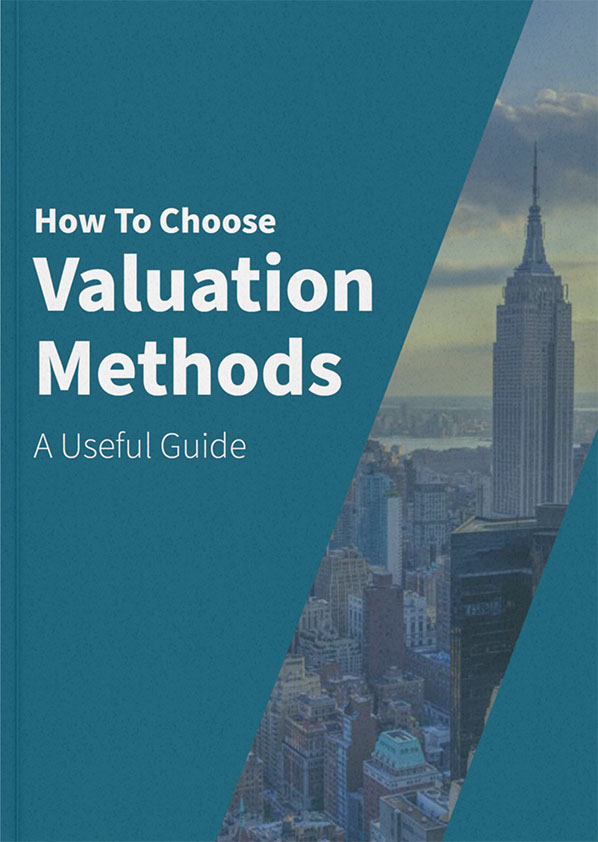Company Valuation Methods—Complete List and Guide

Whether you’re an investor, a potential buyer, or a business owner, knowing which valuation methods to apply is extremely important. In this article we explore some of the main valuation methods, including when to adopt them.
So, what are the main company valuation methods? There are three primary approaches under which most valuation methods sit, which include the income approach, market approach, and asset-based approach. The income approach estimates value based on future earnings, using techniques like the discounted cash flow analysis. The market approach compares the company to similar publicly traded businesses, or those recently sold or involved in some transaction. The asset-based approach evaluates net asset value by subtracting liabilities from total assets. Each method has its strengths and is chosen based on company specifics, industry trends, and valuation goals.
So before we dive into each approach and the methods that sit beneath them more thoroughly, let’s take a quick tour of key takeaways so you start off understanding some of the key insights.
Key Takeaways:
- Market cap is extensively used for publicly traded companies because it provides a straightforward way to gauge a company’s value based on the stock price and the number of outstanding shares. But this is not applicable when it comes to valuing private businesses.
- Three primary approaches exist including the income-based, market-based, and asset-based approaches.
- The choice of method depends on the type of business, industry, and the specific context of the valuation.
- The income-based approach determines a company’s value by assessing its anticipated future income-generating potential, employing methodologies such as Discounted Cash Flow (DCF) Analysis, Capitalization of Earnings, the Income Multiplier Method, Dividend Discount Model (DDM), and Earnings-Based Valuation.
- Market-based approaches gauge a company’s value by analyzing comparable market transactions and valuations. This is accomplished through methods like Comparable Company Analysis, Precedent Transaction Analysis, and Market Capitalization, which collectively offer insights into the company’s value within the context of the broader market landscape.
- Asset-based approaches determine a company’s value by evaluating its underlying tangible and intangible assets. These methods encompass Book Value, Liquidation Value, and Replacement Cost Analysis, providing a comprehensive understanding of the company’s value grounded in its assets‘ worth and potential.
- DCF analysis is often considered the gold standard for intrinsic valuation but requires detailed financial data.
- Comparative methods like CCA and industry-specific methods are valuable for benchmarking.
- Valuation methods should be chosen based on the specific needs and goals of the valuation.
- There are a number of other valuation methods that do not neatly fall into the above categories due to their unique approaches or considerations depending on the type of company being dealt with. Some examples include Liquidation Valuation, Replacement Cost Valuation, Real Options Valuation and Contingent Claim Valuation
- Company valuation is influenced by several factors, including industry trends, market conditions, financial performance, competitive positioning, and the quality of management and leadership.
How Do I Value a Business? The Short Answer
In brief, accurately valuing a business often requires in-depth knowledge of valuation methods and industry specifics, something professionals develop expertise in over many years. However, it’s also possible for regular individuals to grasp the fundamental approaches used by experts and, in certain cases, make basic estimates of a business’s potential value through simple calculations.
While many people are familiar with market capitalization as a method for understanding the general worth of publicly traded companies based on the current market sentiment (itself based on company performance, etc.), there are different methods employed by professionals to provide company valuations. The primary approach often involves a version of Discounted Cash Flow (DCF) analysis, which may often be used in conjunction with a market-based approach like Comparable Company Analysis (CCA) or Comparable Transactions Analysis (CTA). However there are many variations.
A DCF analysis estimates a company’s value by projecting its future cash flows, making it well-suited for long-term investment decisions and assessing a company’s fundamental financial health. On the other hand, CCA compares a company to similar peers, facilitating relative valuation and benchmarking. These methods find common use in scenarios such as mergers and acquisitions, investment evaluations, and when seeking a comprehensive understanding of a company’s financial prospects. Additionally, asset-based valuation methods become essential when tangible assets or intellectual property represent a substantial portion of a company’s overall value.
What are the different Company Valuation Methods?
Before we dive into the specific valuation methods, it’s essential to understand the three topline categories of approach used to assess a company’s value:
Income-Based Valuation
Income-based valuation methods determine a company’s worth based on its expected future income-generating capacity. These approaches consider the company’s ability to generate profits and cash flows over time and discount them back to their present value to arrive at the current valuation.
Market-Based Valuation
Market-based approaches, also known as market value methods, directly use market prices and market metrics to determine a company’s value. These approaches rely on comparing the target company you’re valuing, to other similar companies via some financial metric, such as a P/E ratio.
Asset-Based Valuation
Asset-based valuation methods determine a company’s worth based on the value of its net assets, which includes tangible and intangible assets (minus its liabilities). These approaches may be particularly useful when a company’s intrinsic value is closely tied to its physical or intellectual assets.
Different approaches, or a combination of different approaches, may be applied depending on the company being valued and the purpose of the valuation.
Methods to Value a Business #1 – Income-based Approaches
i) Discounted Cash Flow (DCF) Analysis
The DCF is a widely used method that forecasts a company’s future cash flows and discounts them back to their present value using a discount rate. By considering the time value of money, DCF estimates a company’s future cash flows‘ worth in today’s dollars, making it popular among investors and analysts for assessing growth and profitability. For a thorough description and explanation of a DCF, see our full DCF article here.
ii) Capitalization of Earnings
This method estimates a company’s value by dividing its expected annual earnings by a capitalization rate. The capitalization rate represents the expected rate of return investors would demand from the investment. This method is particularly useful for stable, mature companies with predictable earnings.
iii) Income Multiplier Method
The income multiplier method uses a multiple of a company’s earnings or cash flows to determine its value. This method is common in industries where valuations are commonly expressed as a multiple of Earnings Before Interest, Taxes, Depreciation, and Amortization (EBITDA) or Earnings Before Interest and Taxes (EBIT).
iv) Dividend Discount Model (DDM)
Focuses specifically on valuing companies that pay dividends to their shareholders. It estimates a company’s value by discounting its future dividend payments back to their present value. The DDM assumes that dividends grow at a constant rate over time and provides a valuation based on expected future dividends.
v) Earnings-based Valuation
Earnings-based valuation methods use various metrics related to a company’s earnings to assess its value. The Price/Earnings (P/E) ratio, for example, compares a company’s stock price to its earnings per share, providing insight into the market’s valuation of its earnings generating capacity. Other metrics like the Earnings Per Share (EPS) and Earnings Before Interest, Taxes, Depreciation, and Amortization (EBITDA) are also commonly used for earnings-based valuation.
Methods to Value a Business #2 – Market-based Approaches
i) Comparable Company Analysis (CCA)
CCA involves comparing key financial metrics, such as P/E ratio and P/B ratio, of the target company with those of similar publicly traded companies. This approach is commonly used in the valuation of private companies or companies without readily available market prices.
For Example:
Comparing „Company XYZ“ in the technology industry with peers like Apple, Microsoft, Alphabet, Amazon, and Facebook. Analyzing financial metrics (P/E ratio, P/S ratio) of the group helps estimate Company XYZ’s valuation relative to its industry competitors. Adjustments are made for differences in growth prospects and market position. CCA provides insights to make informed investment decisions.
ii) Precedent Transactions Analysis (PTA)
PTA involves analyzing past acquisition deals in the same industry to assess the valuation multiples paid by acquirers for similar companies. This method provides insights into how the market values comparable companies in merger or acquisition scenarios.
iii) Market Capitalization
Market capitalization is a simple market-based method that calculates a company’s value by multiplying its current stock price by the number of outstanding shares. It represents the total market value of the company’s equity.
Ratios
i) EV/EBITDA (Enterprise Value to Earnings Before Interest, Taxes, Depreciation, and Amortization)
EV/EBITDA is a valuation ratio used to assess a company’s overall profitability before accounting for financing decisions, taxes, and non-cash expenses. It indicates how much an investor is willing to pay for a company’s operating earnings (EBITDA). A lower EV/EBITDA ratio suggests that a company may be undervalued, while a higher ratio could indicate an overvaluation.
For example:
Company ABC’s Enterprise Value is $2.5 billion, and EBITDA is $500 million. Calculating EV/EBITDA: $2.5 billion / $500 million = 5. The resulting ratio of 5 indicates that investors are willing to pay 5 times the company’s EBITDA for its enterprise value.
ii) EV/EBIT (Enterprise Value to Earnings Before Interest and Taxes)
Similar to EV/EBITDA, EV/EBIT is a valuation multiple that focuses on a company’s profitability, but it excludes the impact of depreciation and amortization. It provides insight into a company’s operational performance without considering the impact of non-cash expenses. A lower EV/EBIT ratio indicates a potentially better value for investors.
iii) EV/Sales (Enterprise Value to Sales)
EV/Sales is a valuation ratio that relates a company’s enterprise value (market value of equity plus net debt) to its total revenue. It measures how much investors are willing to pay for each dollar of a company’s sales. A lower EV/Sales ratio might suggest a more attractive valuation, while a higher ratio could indicate that the market values the company’s sales at a premium.
iv) Price/Earnings (P/E) Ratio
The P/E ratio compares a company’s stock price to its earnings per share. It is a popular metric for assessing a company’s relative value in relation to its earnings generating capacity. A higher P/E ratio typically indicates that investors expect higher future growth from the company.
v) Price/Book (P/B) Ratio
The P/B ratio compares a company’s stock price to its book value per share. It is used to assess a company’s valuation relative to its net asset value. A P/B ratio greater than 1 suggests that the market values the company’s assets above their book value.
Methods to Value a Business #3 – Asset-based Approaches
i) Book Value Method
The book value method calculates a company’s value by subtracting its total liabilities from its total assets, as recorded in its balance sheet. While this method provides a straightforward measure of a company’s net worth, it may not capture the true economic value of assets, particularly intangible assets like patents, copyrights, or brand value.
For example:
The book value of Microsoft Corporation is $119,639 million. This represents the net value of the company’s assets after deducting its liabilities. However, as mentioned before, book value is just one aspect of a company’s valuation, and investors consider various other factors and valuation methods to make well-informed investment decisions.
ii) Liquidation Value Method
The liquidation value method estimates a company’s value if its assets were sold off and its liabilities settled in a liquidation scenario. This approach is relevant in cases of distressed companies or bankruptcy, where the company’s assets are valued based on their fair market value in a forced sale.
iii) Replacement Cost Method:
The replacement cost method values a company based on the cost of replacing its assets at their current market prices. This approach is most applicable to asset-heavy industries, such as manufacturing or real estate, where the value of physical assets significantly influences the company’s overall worth.
Want to simplify your valuation calculations? Book a demo to see how the Valutico platform effortlessly calculates 28 valuation methods.
Other Valuation Methods and Approaches
In addition to the intrinsic, market-based, asset-based, and income-based valuation approaches, there are other less commonly used methods that can provide valuable insights into a company’s worth. While these approaches may be more specialized or applicable in specific situations, they contribute to a comprehensive understanding of a company’s value.
i) Liquidation Valuation
Liquidation valuation estimates a company’s worth in a worst-case scenario, assuming its assets are sold and liabilities settled. It is vital for distressed companies, bankruptcy, or assessing asset value during liquidation.
ii) Replacement Cost Valuation
The replacement cost valuation determines a company’s value by replicating its assets and operations. Common in asset-driven industries like manufacturing or natural resources, it assesses the benefits of building versus buying assets relative to market value.
iii) Real Options Valuation
Real options valuation enables a technology company to assess a new software project while considering flexibility in response to market changes. For instance, a company may have the option to abandon a project if the market doesn’t favor it, or expand it if it shows promising growth. This approach allows for better investment decisions.
iv) Contingent Claim Valuation
Contingent claim valuation is used to assess the value of companies with complex capital structures, such as those with convertible bonds or options. It considers the value of various claims on the company’s assets and cash flows, including debt, equity, and derivatives. This method is complex and requires advanced financial modeling techniques.
v) Real Estate Valuation
Real estate valuation methods are specifically tailored to assess the worth of properties, real estate assets, or real estate investment trusts (REITs). These methods consider factors such as location, property type, rental income, and future development potential to arrive at the property’s value.
vi) Venture Capital (VC) Method
The venture capital method is commonly used to value early-stage startups or companies seeking venture capital funding. It involves estimating the company’s potential exit value (through acquisition or initial public offering) and working backward to determine the present value that justifies the expected returns for investors.
vii) Economic Value Added (EVA) Valuation
Economic Value Added is a performance metric that calculates a company’s true profitability after deducting the cost of capital from its net operating profit. EVA valuation helps identify companies that generate value above their cost of capital and indicates their economic profit.
Market Value Ratios
Market value ratios offer valuable insights into a company’s value relative to its market price and other financial metrics. Some common market value ratios include:
Price/Sales (P/S) Ratio:
Compares a company’s stock price to its revenue per share, providing a measure of market valuation relative to sales.
Price/Cash Flow (P/CF) Ratio:
Compares a company’s stock price to its operating cash flow per share, offering insights into its valuation relative to cash generation.
Price/Earnings to Growth (PEG) Ratio:
Relates a company’s P/E ratio to its expected earnings growth rate, helping to identify undervalued or overvalued stocks relative to growth prospects.
Intangible Asset Valuation:
Valuing intangible assets, such as patents, trademarks, brand value, and intellectual property, is essential in industries where intangibles contribute significantly to a company’s worth. Various methods, like the Relief from Royalty approach or the Multi-Period Excess Earnings method, are used to estimate the value of intangible assets.
Option Pricing Models:
Option pricing models, like the Black-Scholes model, can be used to value a company’s equity or equity-based compensation plans, such as stock options or employee stock ownership plans (ESOPs).
Residual Income Valuation:
Residual income valuation measures a company’s economic profit by comparing its net income to the required return on equity. It focuses on the net income that exceeds the cost of capital and indicates whether a company is creating value for shareholders.
Sum-of-the-Parts Valuation:
This method breaks down a company into its individual business units or segments and values each segment separately based on relevant valuation techniques. The sum of the individual segment values gives the total company valuation.
Greenfield Valuation:
Greenfield valuation is used to assess the potential value of a new project or investment for a company. It considers the costs, cash flows, and risks associated with the new venture to determine its viability and potential returns.
Factors Affecting Company Valuation
A company’s valuation is influenced by a multitude of factors that reflect its financial health, operational efficiency, growth potential, and industry dynamics. Understanding these factors is crucial for conducting accurate valuations and making well-informed investment decisions. Some of the key factors affecting company valuation include:
i) Industry Trends and Market Conditions
The performance of a company is often linked to the overall health and growth prospects of its industry. Favorable industry trends and market conditions can boost a company’s valuation, while unfavorable trends may have the opposite effect.
ii) Financial Performance
A company’s historical and projected financial performance plays a significant role in determining its value. Factors such as revenue growth, profitability, and operating margins are closely scrutinized during the valuation process.
iii) Competitive Positioning
The competitive landscape and a company’s position within its industry are critical considerations in valuation. A company with a strong competitive advantage and market leadership may command a higher valuation than its competitors.
iv) Management Quality and Leadership
The competence and track record of a company’s management team are important factors that can impact its valuation. A strong management team with a successful track record can instill confidence in investors and positively affect the company’s value.
v) Economic Environment
The overall economic conditions, including interest rates, inflation, and GDP growth, can influence company valuations. Economic downturns may result in lower valuations, while strong economic growth can lead to higher valuations.
Each valuation approach has its strengths and limitations, and the choice of method depends on the company’s characteristics, the industry it operates in, and the context of the valuation. By considering a wide array of valuation approaches and understanding the factors that influence a company’s worth, investors, analysts, and businesses can make more informed decisions when assessing investment opportunities, making acquisitions, or evaluating their own financial health. As the financial landscape evolves, mastering these valuation techniques remains essential for navigating the complexities of the business world and maximizing value for stakeholders.




